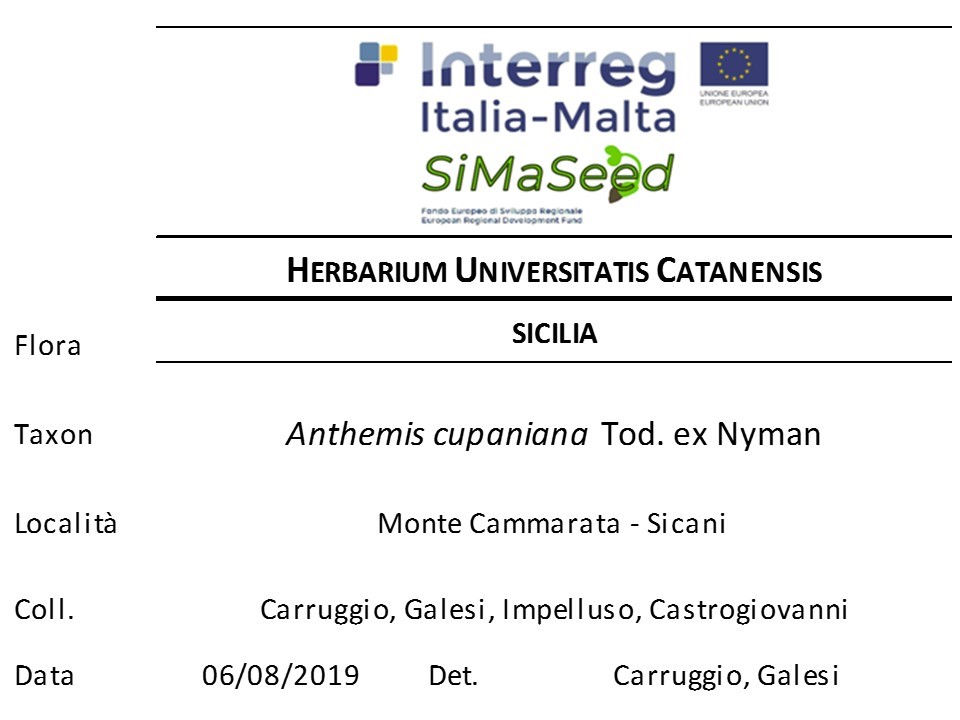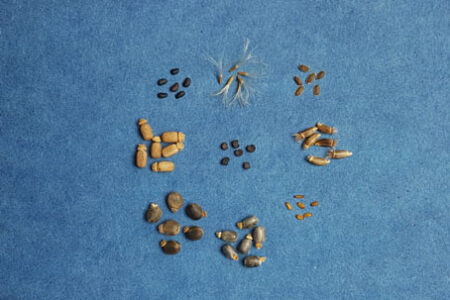Field activities include the identification and phenological monitoring of natural populations, the collection of herbarium samples for the correct identification of the species and seed collection.
The sampling sites of the germplasm were chosen on the basis of the distribution of the target species and the suitability of the population for size, ecological specificity and isolation in respect to others.
Herbarium sample collection
An identification tag is applied to each herbarium sheet with the scientific name of the species, location and date of collection, name of the collector (Legit) and who identifies the sample (Determinavit).

Herbarium samples
Germplasm collection (seeds)
Seed collection of the project species was preliminarily authorized by the competent authorities and conducted without causing damage to natural populations. The samplings were carried out in such a way as to ensure the widest representation of the genetic diversity of the sampled populations through a random collection conducted of no less than 50 individuals.
Post-maturation
During the harvesting of seeds in nature, it is possible to take material with different degrees of maturation. Thus, in the laboratory, in order to obtain homogeneous batches of seeds, a post-maturation period is used, under controlled temperature and relative humidity conditions.
(temperature ≤ 20 ° C and RH ≤ 50%).
In some species, the seeds released by mother plants can be affected by dormancy. In the case of a non-deep dormancy, during post-maturation, a series of physiological changes may occur, borne by the embryo, which will allow germination.
Seed Cleaning
Germplasm banks have a laboratory prepared for seed cleaning. Seed cleaning is carried out after an eventual post-ripening period.
The cleaning operations consist of the manual extraction of the seeds, without damaging the sample, and in the removal of waste plant material. Variable inter-mesh sieves, an automatic siever (Multidimensional Sieveshaker IG / 1 / S – Giuliani Tecnologie s.r.l) and variable air flow gravimetric seed cleaner (Mod. CB1 Column Seed Cleaner, Agriculex Inc.) are used. The selection of homogeneous batches of seeds is carried out through visual analysis under a binocular stereoscopic microscope.
Seed characterisations
The quantitative and qualitative characterisation of the seed lots is carried out with the estimated average weight of 1000 seeds (based on 5 replicates of 50 seeds), the consistency of the accessions based on the average weight of 1000 seeds, the viability (cut test or Tetrazolium test – 2,3,5-triphenyl tetrazolium chloride) and viability (germination test).

Dehydration
For seed dehydration, the BGS-CT is equipped with a dehydration chamber with a temperature of 15 ° C and relative humidity of 15% (KW Apparecchi Scientifici, 2021), with a dehumidifier (Munters, mod. ML180 HPS E) and two refrigeration systems for temperature control. Inside the dehydration chamber the internal humidity of the seeds is constantly monitored, recording the trend over time of the water activity (HygroPalm 23-AW equipped with HC2-AW probe, Rotronic) and the moisture content (scale MS205DU Dual Range analytical with maximum capacity 220g, resolution 0.01 mg), in order to evaluate the degree of dehydration of the seeds and the attainment of optimal parameters for long-term storage.
Long-term packaging and storage
In the dehydration chamber, the accessions of seeds are packaged in 10-100 ml glass vials for penicillin with rubber stoppers and aluminum caps, and inserted in turn inside hermetically sealed glass jars with rubber seals. Cobalt-free granular silica gel with a self-indicator is inserted both inside the vials and the jars, a system capable of effectively signaling any infiltration of moisture into the system.
Vials and glass jars are provided with a label that identifies the access, through an alphanumeric code (eg. SiMaSeed / 01/18 / BGS-CT): SiMaSeed, indicating the project for which the batch of seeds was collected; 01/18, the progressive number of the access (ID) and the year of collection; and BGS-CT, indicating the institution, that is, the Germplasm Bank of Catania.
The dehydrated seeds are stored at a low temperature, in a special chamber at a negative temperature of -20 / -22 ° C
Germination test
The germplasm banks BGS-CT, UoM and MGOZ, upgraded or newly established thanks to the financial support of the SiMaSeed project, now have laboratories equipped with incubators with adjustable temperature and light (Mod. MCT 200, Angelantoni) and growth chambers with adjustable temperature, light and humidity (MLR-351H, Sanyo, Japan; MLR-352H, Panasonic, Japan; MLR-352H, PHCbi, Japan; Mod. FITOCLIMA 1200, ARALAB).
Among the activities carried out at the banks’ laboratories, the studies concerning the eco-physiology of germination are of fundamental importance for the definition of the germination protocols of the project target species, which is useful for their propagation. These studies are conducted through germination tests which, in addition to the definition of germinative behavior, allow the evaluation of dormancy.